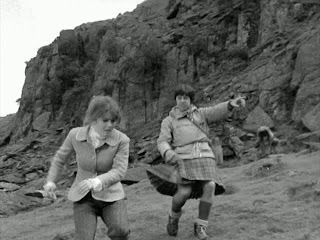 Doctor: Peter Davison (5th Doctor)
Doctor: Peter Davison (5th Doctor)Companion: Nyssa, Tegan Jovanka, Adric
Written by: Terence Dudley
Directed by: Ron Jones
Editor's Note: Hey, kids. Matt here to intro Cassandra back for this week's blog. Don't worry, though. I'll be back next week for "fun" or something. (God help me). But for now, Cassandra's gonna take us through a lovely little two part Davison ditty. It's not very long, but let's be honest: there's not a whole lot to say (as she'll probably tell you). Enjoy!
Background & Significance: "Black Orchid" is an anomaly.
When Johnathan Nathan-Turner was planning for Peter Davison's inaugural season as the Doctor, he managed to get enough of a budget to make 28 episodes--two episodes up from the
 previous standard. Instead, however, he decided to allocate those two extra episodes to making the pilot of the failed spin-off show K-9 and Company. So much for that.
previous standard. Instead, however, he decided to allocate those two extra episodes to making the pilot of the failed spin-off show K-9 and Company. So much for that.Now with two less episodes to make, and having a staunch aversion to the traditional six-part serial, JNT decided to go ahead and have a two-parter, which hadn't been seen on the show since "The Sontaran Experiment" way back in Tom Baker's first season.
Another thing that separates "Black Orchid" from the norm is that there are no sci-fi elements in the story at all. In fact, it's very much a standard murder mystery in the vein of an Agatha Christie novel, even taking place in 1920's England. In an era of Doctor Who marked very heavily by big science fiction concepts and ideas, this serial stands out much like a sore thumb.
But you don't necessarily need the big bendy concepts for a good Doctor Who adventure, which
 this serial proves quite well. While highly atypical, "Black Orchid" is a fun little interlude, which is exactly what our TARDIS crew needs before heading into something like "Earthshock" (the following serial). This story, in the context of the entirety of Season 19, serves as the calm before the storm, a simple, entertaining adventure before the plunge into the next.
this serial proves quite well. While highly atypical, "Black Orchid" is a fun little interlude, which is exactly what our TARDIS crew needs before heading into something like "Earthshock" (the following serial). This story, in the context of the entirety of Season 19, serves as the calm before the storm, a simple, entertaining adventure before the plunge into the next.It also serves as a sort of spotlight on Nyssa, which is great, because I love Nyssa. It's a nice highlight of Sarah Sutton's acting abilities, much in the way the previous story "Kinda" is for Janet Fielding, and "Earthshock" is for Matthew Waterhouse.
And murder mystery. Did I mention murder mystery? Everyone loves a murder mystery.
But enough of all that. Let's take a closer look, shall we?












